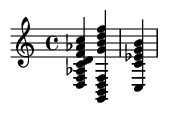Summary:
The minor major seventh chord (mMaj7) is a unique and sophisticated four-note harmony that combines the melancholic quality of a minor triad with the bright tension of a major seventh. Its distinctive sound—haunting, beautiful, and full of emotional complexity—makes it an indispensable tool for jazz musicians, film composers, and any artist seeking to enrich their harmonic language.
Keywords:
minor major seventh, mMaj7, jazz harmony, chord construction, harmonic minor, melodic minor, tension and resolution, film scoring, Hitchcock chord, Bernard Herrmann, sophisticated harmony
Introduction: A Chord of Beautiful Contradictions
In the vast landscape of musical harmony, few chords possess the compelling character of the minor major seventh. It's a chord built on a paradox, blending the somber mood of a minor triad with the bright, upward-pulling energy of a major seventh. This clash of emotions—darkness and light, sorrow and hope—doesn't create dissonance in a jarring way. Instead, it results in a sound that is profoundly complex and evocative, captivating musicians and listeners for generations.
What is a Minor Major Seventh Chord?
A minor major seventh chord is a four-note chord, or "tetrad," built from a specific set of intervals. It consists of a root, a minor third, a perfect fifth, and a major seventh. Essentially, you take a standard minor triad and add a major seventh on top.
Chord Construction Formula:
The formula is 1 - b3 - 5 - 7.
- Root (1): The foundation note.
- Minor Third (b3): Three semitones above the root. This gives the chord its "minor" quality.
- Perfect Fifth (5): Seven semitones above the root. This stabilizes the minor triad.
- Major Seventh (7): Eleven semitones above the root. This adds a bright, lingering tension.
Example: C Minor Major Seventh (CmMaj7)
The C minor major seventh chord contains the notes C - Eb - G - B. Listen to how the melancholic C minor triad (C-Eb-G) is colored by the bright B natural.

Where Does It Come From? The Minor Scales
This chord doesn't appear in the major scale or the natural minor scale, which is why it sounds so unique. Its natural home is as the tonic (i) chord of the Harmonic Minor and Melodic Minor scales. The raised seventh degree in these scales is what creates the major seventh interval above the root.
Context: The C Harmonic Minor Scale
Here is the C Harmonic Minor scale. Notice the B natural at the end. When we build a chord on the first note (C) using notes from this scale, we get C - Eb - G - B: a C minor major seventh chord.

The Sound in Context: Practical Applications
The minor major seventh chord is more than a theoretical curiosity; it's a powerful expressive device used across many genres.
- Jazz: It often functions as a stable tonic minor chord, providing a more colorful and less final-sounding resolution than a simple minor triad. You'll hear it in standards like "My Funny Valentine," "Blue in Green," and "Solar."
- Film and TV Scores: This is the famous "Hitchcock Chord." Composer Bernard Herrmann used it masterfully in the score for Psycho to create an atmosphere of dread, suspense, and psychological instability.
- Bossa Nova and Pop: Composers like Antonio Carlos Jobim used it for its sophisticated, bittersweet color. It has also appeared in the work of artists like Sting and Radiohead.
- Classical Music: Impressionist and 20th-century composers like Ravel, Debussy, and Scriabin explored similar sonorities to break from traditional tonal harmony.
Example: A Classic Jazz Progression
A very common progression in minor keys is the ii-V-i. In jazz, the tonic minor chord (i) is very often a minor major seventh. This progression shows how the tension of the Dm7(b5) and G7 chords resolves to the colorful stability of Cm(maj7).

Voicings and Inversions
How you arrange the notes of a chord (its "voicing") has a huge impact on its sound. This is especially true for the mMaj7 chord, where the close proximity of the major seventh and the root (just a semitone apart when inverted) creates a beautiful, poignant tension. Smooth voice leading between chords is key to making this harmony shine.
Inversions of C Minor Major Seventh:
Below are the four basic positions (root position and three inversions) of the Cm(maj7) chord. Experiment with these shapes on your instrument.
Conclusion: An Essential Color on Your Palette
The minor major seventh chord is one of harmony's most intriguing paradoxes. By understanding its construction, its origins in the minor scales, and its function in context, you can move beyond seeing it as a strange anomaly and begin using it as a powerful tool for emotional expression. Its sophisticated sound can add depth, mystery, and beauty to your compositions and improvisations. Mastering this chord will undoubtedly expand your harmonic palette and enhance your ability to tell complex stories through music.
References:
Levine, Mark. (1995) . The Jazz Theory Book. Sher Music Co.
Persichetti, Vincent. (1961). Twentieth-Century Harmony. W. W. Norton & Company.
Kostka, Stefan & Payne, Dorothy. (2012). Tonal Harmony. McGraw-Hill.
Herrmann, Bernard. (1960). Psycho (Original Motion Picture Score).
